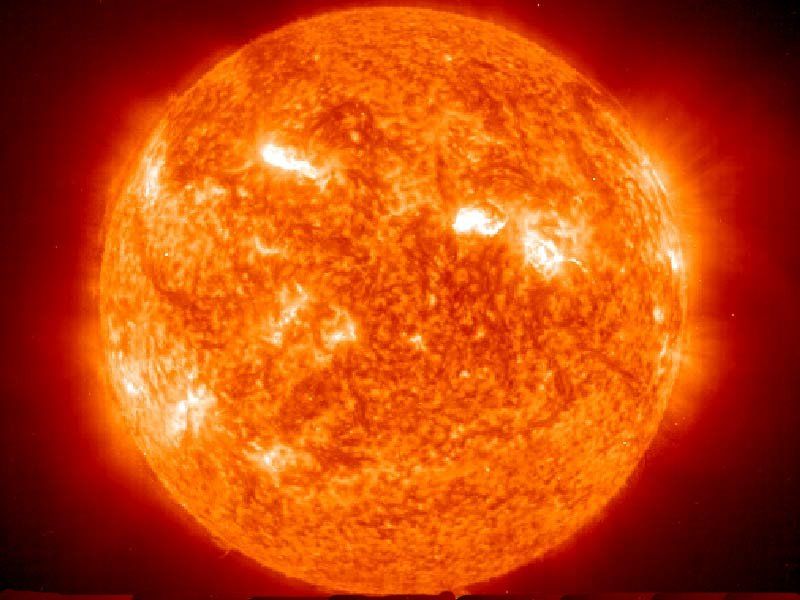This web page is created within BALTICS project funded from the European Union’s Horizon2020 Research and Innovation Programme under grant agreement No.692257.
The Sun as an astronomical object, its structure, main characteristics, life cycle
(formation, evolution, end)
The Sun is the central and largest object in the Solar System. It is a small, not very hot star, formed from a cloud of gas and dust about 4.6 billion years ago. Because of some external forces, probably as the result of a supernova explosion, in some parts of the cloud, denser regions formed. Because of their initial mass, they continued to attract more and more of the surrounding gas and dust. In the central part of the nebula, a sphere formed and continued to grow.
As the star nucleus compressed and became denser, its centre became hotter and hotter. The gas in its core heated up until the temperature exceeded one million degrees Kelvin. Under these conditions, fusion reactions could start. At this point, it can be considered that the Sun was born. It began to produce energy – heat and light.
The Sun — its composition and size
The Sun is classified as a G-type main-sequence star. This means that it uses hydrogen as fuel in nuclear fusion processes. This process results in the formation of helium and the release of energy.
Our Sun contains about 99.8% of the mass of the entire Solar System. This means that the total mass of all the planets, asteroids, comets and dust is only 0.2%. The mass of the Sun is 1.99 x1030 kilograms or about 333,000 times the mass of the Earth. About 75% of the Sun’s mass consists of hydrogen, with helium makes up the remaining 24%.
About 1% is made up of various heavier elements, or “metals”, as scientists call them. These include oxygen, carbon, neon, iron and others.
The Sun is not only massive but also huge compared to Earth. The Sun’s diameter is 1,392,000 kilometres or 109 times that of the Earth.
The total volume of the star is also impressive. If the Sun was hollow, 960,000 Earth-sized balls could fit inside it, but if you wanted to fill the whole void, you would need 1,300,000 Earth-sized balls.
The structure of the Sun
However, the Sun is not hollow. It has the inner layers and the atmosphere. The inner layers of the Sun are the core, the radiative zone and the convective zone. The atmosphere is also made up of three layers: the photosphere, the chromosphere and the corona.
The core is a zone where energy is produced and nuclear fusion reactions occur. There, the temperature reaches about 15 million degrees Kelvin. In this zone, the density of a gas is about 150 times that of water. The core occupies only 0.8% of the Sun’s total volume, but about 34% of the Sun’s mass are contained there. Every second, about 300 million tonnes of hydrogen are used to produce energy. Helium is a by-product of this “burning”.
A unit of energy produced by the Sun is an ultra-high-energy gamma-ray photon. On average, it takes a photon 170,000 years to travel from the Sun’s core to the atmosphere. The next zone after birth in the core that the photon has to traverse is the radiative zone, which covers about 70% of the Sun’s radius. In this zone, the photon moves chaotically, colliding with particles and losing some of its energy.
Then the photon enters the convective zone, where gases are constantly moving. At the boundary with the radiative zone, the gas heats up and rises. When reaching the first layer of the atmosphere, the energy is being radiated and the gas becomes cooler, sinking down. This movement seems reminiscent of a lava lamp.
The heat or infrared radiation, visible light and ultraviolet radiation are emitted from the lowest layer of the atmosphere, the photosphere. Looking at this layer using telescopes equipped with special filters, it is possible to see what are known as granulation or convection cells. Sunspots, which are cooler regions, can be observed in the photosphere. If the average temperature of the photosphere is 6,500 degrees Celsius, the sunspots can cool to as low as 4,000 degrees. This is the reason why the sunspots appear dark in contrast to the rest of the Sun’s brighter surface. Sometimes huge loops of gas — prominences — rise above the photosphere. They are sometimes so large that they extend through the chromosphere (see below) and end in the corona.
The next layer is the chromosphere. In this layer, where the gas is very rarefied, flares form, releasing large amounts of energy in the form of X-rays, ultraviolet radiation and radio waves, and also charged particles — protons and electrons — are ejected into interplanetary space.
The last layer of the Sun’s atmosphere is the corona, which is basically made up of various charged particles. It is the most extensive layer of the Sun’s atmosphere, stretching millions of kilometres. The corona is also much hotter than the photosphere and chromosphere. The corona is easiest to spot during a total solar eclipse, but, nowadays, scientists tend to create artificial eclipses by covering bright Sun’s disk with a coronagraph. This device is used on telescopes both on Earth and in space. Coronal mass ejections, when large amounts of matter are ejected from the Sun, can be observed in the corona as prominences break.



















